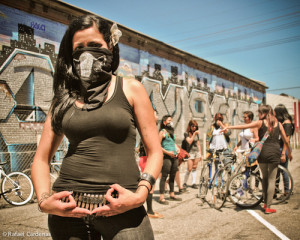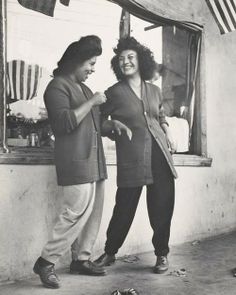Another profound element of the Chicana feminist movement is the formation of Chicana gangs and gang members. The roles of females in gangs undermines social issues involved with sexual exploitation, difficulty establishing identity related to gender, and the breaking of hegemonic female roles. Patricia Acevedo of Chicana Gang Members: Resistance to Traditional Women’s Roles discusses the limited and exploitive roles of women in gangs including the “tomboy” or “sex object” label. Acevedo provides evidence of the factors that draw or push Chicana women to join gangs, “Gangs can be seen as representing a means by which some youth seek to resolve problems presented by their structural and cultural positions in relation to both their families, and processes of racism and sexism in the larger society.” The common Chicana/Chicano, as a part of a minority group, unfortunately faces a great deal of oppression and descrimination. Yet, women, more so than men, suffer an additional tier of oppression due to the hegemonic submissive and sexual context that women are commonly labeled with. In addition to their gender based struggle is the Chicana woman’s mixed heritage, as a Mexican-American, which faces her with societal challenges. These are the main factors that influence Chicana women and adolescents to join gangs.
The exclusive community of a gang creates the feeling of belonging when, as a female minority, Chciana women and adolscents face challenges establishing themselves in external societies. As Chicana women are silenced in many ways by their families and socitety, they find power as a female contributer of a gang given their tough status. Acevedo explains, “When girls and women affiliated with gangs are described, it is often through media stereotypes of “bad” or “evil,” or even overly “masculine” girls.” The association of masculinity with a female in a gang could work to make her feel either empowered or confused with her gender related identity.
This rings true to the character of Turtle from the novel Their Dogs Came With Them by Helen Viramontes. In order to fit in with her brother and the rest of the gang members, Turtle shaves her head and takes on the tough persona of a male. One profound factor that could have driven Turtle away from herself and her society is the unhealthy relationship between her father and mother. She then seeks a feeling of belonging within the walls of the gang while denying her gender to do so. This is not to say that one does not have the freedom and right to take on their prefered gender characteristics, but Turtle’s reasons clearly derived from oppression, a need to belong, and the challenge to establish personal identity. Acevedo contributes, “Gangs have always been viewed as a social problem and as an example of deterioration in society.” In other words, gangs are the tangible representation of social error and corruption. They are the product of a societal problem. For Chicana women and adolescents, gangs work as an escape in which they feel they are gaining a sense of belonging, authority, revenge, and other personal discoveries. In reality, gangs work to exploit these women while creating the illusion that they are a part of a group that exudes authority against society. In reality, the gang is the result of a minority group that, in this case, faces racial, gender, and economic issues that weaken family structures and cause unhealthy social behavior (such as gangs).
Sources: 1.https://research.wsulibs.wsu.edu/xmlui/bitstream/handle/2376/25/02%20Acevedo%20et%20al.pdf?sequence=1
Chicana Gang Members: Resistance to Traditional Women’s Roles by Patricia Acevedo, McNair Scholar Steven R. Burkett, Ph.D., Faculty Mentor Department of Sociology


